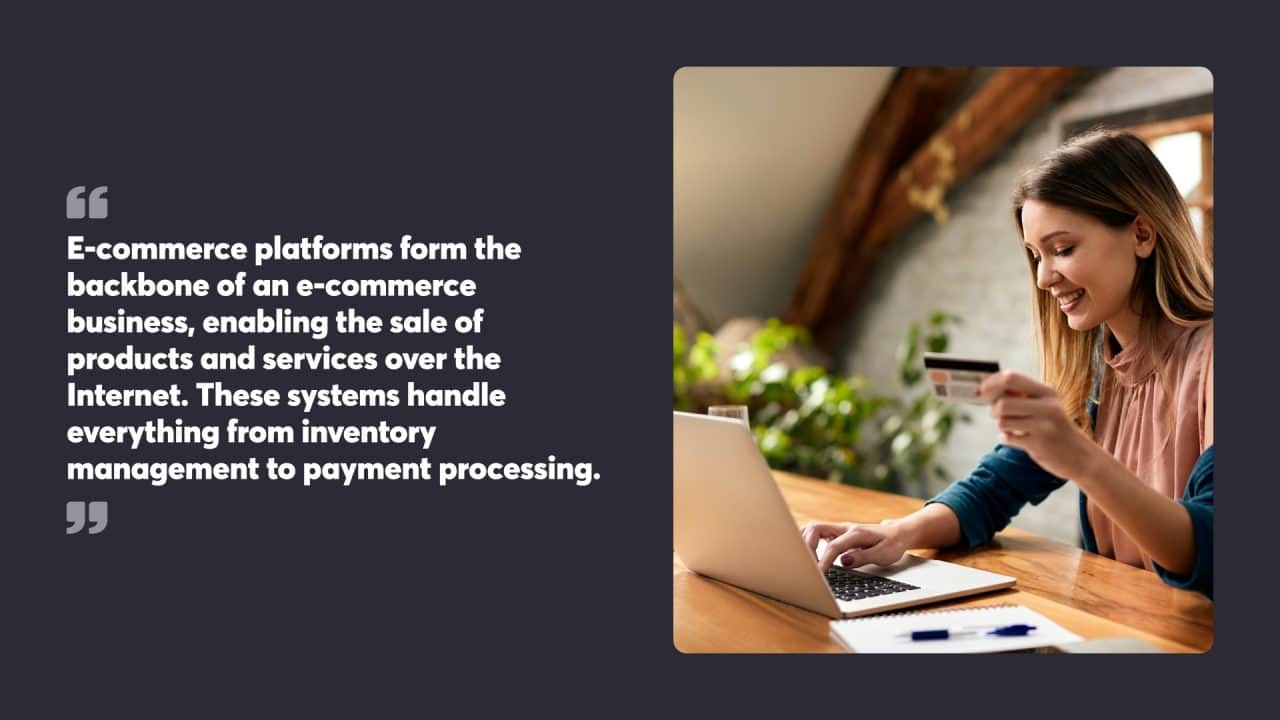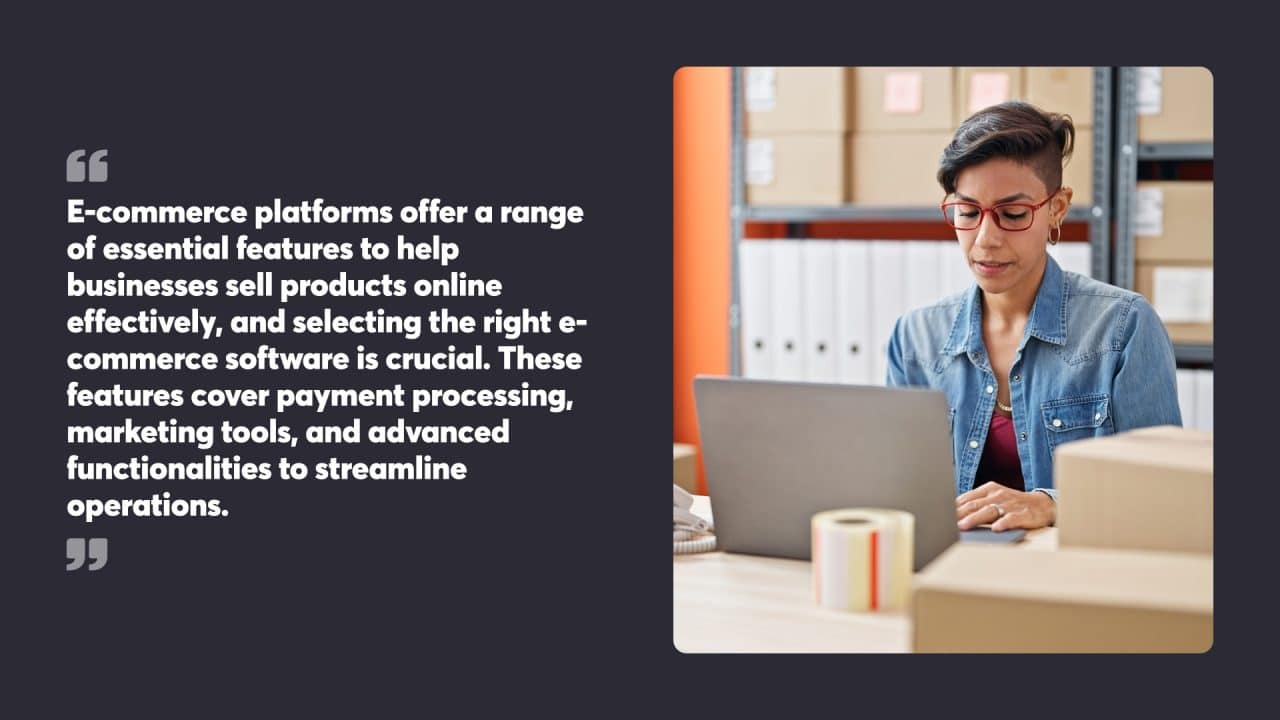
Selecting the best e-commerce platform is a critical decision for any online business. The right choice can propel a company towards success, while the wrong one may hinder growth and frustrate customers. The ideal e-commerce platform aligns with a business’s specific needs, budget, and long-term goals.
E-commerce platforms come in various forms, from simple website builders to complex enterprise solutions. Each offers different features, pricing structures, and levels of customisation. Some focus on ease of use for beginners, while others provide advanced tools for experienced developers and large-scale operations.
When evaluating options, businesses should consider factors such as product catalogue management, payment processing, shipping integration, and mobile responsiveness. Scalability is another crucial aspect, as the chosen platform should be able to grow with the business over time.
Key Takeaways
- Align platform selection with business strategy and growth: Choose an e-commerce platform that meets your current needs while supporting future scalability. Consider factors like product catalogue management, payment processing capabilities, and integration with existing systems to ensure the platform can grow with your business over time.
- Prioritise user experience and mobile optimisation: Select a platform that offers responsive design and mobile-friendly features to cater to the growing number of mobile shoppers. Focus on intuitive navigation, fast loading times, and streamlined checkout processes to enhance the overall user experience and reduce cart abandonment rates.
- Balance security, performance, and multi-channel integration: Opt for a platform that provides robust security measures and data protection protocols while also offering high performance and the ability to integrate with multiple sales channels. This combination will help protect customer data, ensure smooth operations during high-traffic periods, and expand your reach across various marketplaces and social media platforms.

Table of Contents
Understanding Ecommerce Platforms
E-commerce platforms form the backbone of an ecommerce business, enabling the sale of products and services over the Internet. These systems handle everything from inventory management to payment processing.
Global Retail E-commerce Sales Trends
The e-commerce sector continues to grow rapidly worldwide, with global retail ecommerce sales reaching $4.9 trillion in 2021. Projections suggest this figure could surpass $7 trillion by 2025. Mobile commerce is driving much of this growth, accounting for over 70% of e-commerce transactions in some markets.
China remains the largest e-commerce market, followed by the United States and the United Kingdom. Emerging markets in Southeast Asia and Latin America are experiencing rapid e-commerce adoption, presenting new opportunities for online retailers.
Cross-border e-commerce is becoming increasingly popular, allowing businesses to reach customers globally. This trend has led to the rise of international marketplaces and localised shopping experiences.
Ecommerce Platform Basics
E-commerce platforms provide the technical infrastructure for an ecommerce platform, enabling online stores to operate efficiently. They typically include features such as product catalogues, shopping carts, and secure payment gateways. Many platforms also offer tools for marketing, customer relationship management, and analytics.
There are three main types of e-commerce platforms:
- Open-source platforms: Customisable and often free to use, but require technical expertise to set up and maintain.
- Software-as-a-Service (SaaS) platforms: Hosted solutions with lower upfront costs and easier setup, but less flexibility.
- Headless commerce: Separates the front-end and back-end, allowing for greater customisation and integration with other systems.
When choosing a platform, businesses should consider factors such as scalability, security, and integration capabilities. The right platform can help streamline operations and improve the customer experience, contributing to the growth of commerce sales.

Assessing Your Business Needs
Evaluating your business requirements is crucial when choosing the right ecommerce platform. This process involves analysing product management needs and understanding your target market for effective customer engagement.
Product and Inventory Management Considerations
Efficient inventory management forms the backbone of a successful online business. A suitable e-commerce platform should offer tools to track stock levels, set reorder points, and manage product variants. It’s vital to choose a system that can handle your current product range and accommodate future growth.
The platform should support bulk product uploads and updates, saving time and reducing errors. Look for features like automated inventory alerts and the ability to sync stock across multiple sales channels. Consider whether you need support for digital products, subscriptions, or customisable items.
Integration with suppliers and warehouses can streamline operations. Assess whether the platform offers barcode scanning, real-time inventory updates, and order fulfilment capabilities.
Target Market and Customer Engagement
Understanding your target market is key to selecting the right e-commerce platform. Consider the demographic and shopping habits of your customers. Do they prefer mobile shopping? If so, prioritise platforms with responsive designs and mobile-optimised checkout processes.
Customer engagement tools can boost sales and loyalty. Look for features such as product reviews, wishlists, and personalised product recommendations. Social media integration can help expand your reach and engage customers where they spend time online.
Email marketing capabilities are valuable for nurturing leads and retaining customers. Some platforms offer built-in email tools, while others integrate with popular email marketing services.
Consider whether you need multilingual or multi-currency support to cater to a global audience. Analytics tools can provide insights into customer behaviour, helping you refine your marketing strategies and improve the shopping experience.
Exploring Types of E-commerce Platforms
Ecommerce platforms come in different forms, each with distinct characteristics and benefits. The choice between SaaS and self-hosted solutions, as well as open-source and proprietary software, can significantly impact an online business.
SaaS vs Cloud Hosted E-commerce Platforms
SaaS (Software as a Service) e-commerce platforms offer cloud-based solutions that handle hosting, security, and updates. Cloud-hosted ecommerce platforms offer cost-effectiveness and ease of implementation compared to in-house solutions. Popular examples include Shopify and BigCommerce. These platforms provide quick setup and maintenance-free operation, making them suitable for small to medium-sized businesses.
Self-hosted solutions, like Adobe Commerce or WooCommerce, give users full control over their e-commerce site. They require more technical knowledge but offer greater customisation options. Self-hosted platforms are often chosen by larger businesses or those with specific needs that SaaS solutions can’t meet.
Open Source vs Proprietary Software
Open-source e-commerce platforms, such as WooCommerce and PrestaShop, allow users to access and modify the source code. This flexibility enables extensive customisation and community-driven development. Open-source solutions are often free to use but may require additional costs for hosting and extensions.
Proprietary software, like Shopify and BigCommerce, offers ready-made solutions with regular updates and dedicated support. These platforms typically charge monthly fees but provide a more streamlined experience with integrated features and security measures. Proprietary solutions are favoured by businesses seeking reliability and ease of use.

Key Features of E-commerce Platforms
E-commerce platforms offer a range of essential features to help businesses sell products online effectively, and selecting the right ecommerce software is crucial. These features cover payment processing, marketing tools, and advanced functionalities to streamline operations.
Payment and Checkout Options
Modern e-commerce platforms support multiple payment gateways, giving customers flexibility in how they pay. Popular options include credit cards, PayPal, and digital wallets like Apple Pay. Some platforms offer built-in payment processing, while others integrate with third-party providers.
Secure checkout is vital. Look for platforms with SSL certificates and PCI DSS compliance to protect customer data. One-page checkout can reduce cart abandonment by simplifying the purchase process.
Many platforms also support features like saved payment methods for returning customers and the ability to offer discounts or gift cards at checkout.
SEO and Marketing Capabilities
SEO tools are crucial for improving visibility in search engine results. Quality platforms offer customisable meta titles and descriptions, XML sitemaps, and canonical tags. Some include built-in keyword research tools to help optimise product listings.
Content marketing features like blogs and landing page builders can boost SEO efforts. Email marketing integrations allow businesses to send targeted campaigns and abandoned cart reminders.
Social media integration is another key feature, enabling easy sharing of products and automatic posting of new items to platforms like Facebook and Instagram.
Advanced E-commerce Functionalities
Inventory management tools help track stock levels and alert when items need reordering. Some platforms offer multi-channel selling capabilities, syncing inventory across marketplaces like eBay and Amazon.
Advanced e-commerce functionalities are essential for a comprehensive ecommerce solution. Product customisation options allow businesses to offer personalised items. This might include size charts, colour swatches, or the ability for customers to upload their own designs.
Analytics dashboards provide insights into sales trends, customer behaviour, and marketing performance. Advanced platforms may offer AI-powered recommendations to boost average order value.
Mobile responsiveness is essential, with many shoppers using smartphones to browse and buy. Look for platforms that automatically optimise the shopping experience for different devices.

E-commerce Platform Scalability and Performance
Scalability and performance are crucial aspects of choosing the right ecommerce platform. They impact a store’s ability to handle increased traffic, process transactions efficiently, and support business growth.
Handling Traffic and Transactions
A robust e-commerce platform should manage high traffic volumes without slowdowns or crashes. This is especially important during peak shopping periods like sales events or holidays. The platform must process multiple transactions simultaneously, maintaining quick page load times and smooth checkout processes.
Load balancing and caching mechanisms help distribute traffic across servers, preventing bottlenecks. Content delivery networks (CDNs) can boost performance by serving static content from locations closer to users. Regular performance testing helps identify and address potential issues before they impact customers.
Growth and Expansion Capabilities
The best e-commerce platforms offer flexible scaling options to support business growth. This includes the ability to add new products, categories, and features without compromising site speed or functionality. Platforms should allow for easy integration of third-party tools and services as business needs evolve.
Database scalability is key for managing increasing amounts of product and customer data. Cloud-based solutions often provide advantages in this area, allowing resources to be added or removed as needed. The platform should also support expansion into new markets, with multi-language and multi-currency capabilities.
API support enables connections with other business systems, such as ERPs or CRMs, supporting streamlined operations as the business grows. Regular platform updates and improvements help keep the online store competitive in the fast-changing e-commerce landscape.

Design and User Experience for a Successful Online Store
Design and user experience are crucial elements in maintaining a successful ecommerce site. They directly impact customer satisfaction, conversion rates, and overall business success.
Mobile Optimisation
Mobile optimisation is vital for e-commerce websites. With the growing number of shoppers using smartphones and tablets, a mobile-friendly design is no longer optional. Responsive layouts adapt to different screen sizes, providing a consistent experience across devices. Fast loading times are essential, as mobile users often have limited patience. Simplified navigation and streamlined checkout processes cater to mobile users’ needs.
Progressive web apps (PWAs) offer an app-like experience within a browser, combining the best of mobile websites and native apps. They provide offline functionality, push notifications, and faster performance, enhancing the mobile shopping experience.
User Interface Design
A well-designed user interface (UI) is key to a successful e-commerce website. Clear, intuitive navigation helps customers find products quickly. High-quality product images and detailed descriptions aid decision-making. Effective search functionality with filters and sorting options improves product discovery.
Visual hierarchy guides users’ attention to important elements like call-to-action buttons. Consistent branding and colour schemes create a cohesive look. Easy-to-use forms and a straightforward checkout process reduce cart abandonment. Accessibility features make the site usable for all customers, including those with disabilities.

Multi-Channel Integration
Most ecommerce platforms offer multi-channel integration, allowing e-commerce businesses to sell across various platforms simultaneously. This approach expands reach and boosts sales potential by tapping into diverse customer bases.
Synchronising Sales Channels
Multi-channel e-commerce platforms offer centralised management of product listings, inventory, and orders across multiple sales channels. These solutions automate data syncing between channels, reducing manual work and errors. Real-time inventory updates prevent overselling and stockouts.
Most platforms integrate with popular marketplaces like Amazon, eBay, and Etsy. They also connect with social media shops on Facebook and Instagram. Advanced systems support custom integrations for niche marketplaces or specialised sales channels.
Pricing and promotion management across channels is another key feature. Businesses can set channel-specific prices or run promotions on selected platforms. Some tools offer automated repricing to stay competitive on marketplaces.
Social Media and Marketplaces
Social media platforms and online marketplaces have become essential sales channels for e-commerce businesses. Many multi-channel platforms offer direct integrations with these channels, simplifying the selling process.
Facebook Shops and Instagram Shopping allow businesses to tag products in posts and stories, creating shoppable content. Pinterest also supports buyable pins. These integrations enable seamless product discovery and purchase without leaving the social platform.
Marketplace integrations often include tools for optimising listings and managing seller accounts. Some platforms provide analytics to track performance across different marketplaces. This data helps businesses identify top-performing channels and products.
Mobile apps from multi-channel providers allow sellers to manage operations on the go. They typically offer features like order processing, inventory updates, and customer communication across all connected channels.
Cost Considerations
Selecting an e-commerce platform involves careful evaluation of various financial aspects, and popular ecommerce platforms offer different pricing structures. Upfront and ongoing expenses can significantly impact a business’s bottom line and long-term success.
Subscription and Transaction Fees
Many e-commerce platforms charge monthly or yearly subscription fees. These can range from $30 to $300 per month, depending on the platform’s features and capabilities. Some providers offer tiered pricing structures, allowing businesses to choose plans that align with their needs and budget.
Transaction fees are another key consideration. Some platforms take a percentage of each sale, typically between 0.5% and 2%. Others may charge flat fees per transaction. It’s vital to calculate potential transaction costs based on projected sales volumes to get an accurate picture of total expenses.
Payment processing fees also factor into overall costs. These usually range from 2% to 3% plus a small fixed fee per transaction. Some platforms partner with specific payment gateways, which may impact processing fees.
Ongoing Maintenance and Support Costs
E-commerce platforms require regular updates and maintenance to function smoothly and securely. While some providers include basic maintenance in their subscription fees, others charge extra for updates, security patches, and technical support.
Support costs can vary widely. Some platforms offer limited free support, with additional charges for priority assistance or more complex issues. Others include comprehensive support in their higher-tier plans.
Customisation and integration expenses should also be considered. Adding new features or connecting with third-party tools often involves additional costs, either through platform-specific apps or developer time.
It’s wise to factor in potential scaling costs as your business grows. Some platforms charge more for increased traffic, storage, or product listings, which can impact long-term affordability.

Security and Data Protection
Robust security measures and strong data protection protocols are fundamental for any e-commerce platform. These elements safeguard sensitive information and build customer trust.
Payment Security
E-commerce platforms must prioritise secure payment processing to protect customers’ financial data. SSL certificates encrypt data transmission between customers and the website, making it unreadable to potential hackers. PCI DSS compliance is crucial for platforms handling credit card information. This standard sets requirements for secure data storage, network architecture, and regular security testing.
Multi-factor authentication adds an extra layer of security for customer accounts. Tokenisation replaces sensitive card data with unique tokens, reducing the risk of data theft. Fraud detection systems use machine learning to spot suspicious transactions and flag them for review.
Customer Data Privacy
E-commerce platforms need strict policies to protect customer personal information. Clear privacy policies outline how data is collected, used, and shared. Platforms should only collect necessary data and give customers control over their information.
Data encryption at rest and in transit keeps customer details safe from unauthorised access. Regular security audits help identify and fix vulnerabilities. Platforms must comply with data protection regulations like GDPR or CCPA, depending on their target markets.
Access controls limit who can view customer data within the organisation. Employee training on data handling best practices is essential. Implementing data retention policies ensures old information is securely deleted when no longer needed.

Choosing the Right Ecommerce Platform for Your Business
Selecting an e-commerce platform requires careful consideration of several factors to create a successful online store. Business needs should guide the decision-making process. Companies must assess their budget, technical capabilities, and growth plans.
Popular platforms like Shopify, WooCommerce, and Prestashop offer different features and pricing structures. Shopify provides a user-friendly interface and comprehensive support. WooCommerce integrates well with WordPress sites. Prestashop suits businesses seeking customisation options.
Scalability is a key consideration. The chosen platform should accommodate future growth without requiring a complete overhaul. Compatibility with existing systems and third-party tools is also important.
Security features and payment gateway options warrant close attention. Robust security measures protect customer data and build trust. A wide range of payment options can increase sales and customer satisfaction.
Mobile responsiveness is non-negotiable in today’s market. The platform should create a seamless shopping experience across all devices. Search engine optimisation (SEO) capabilities can significantly impact online visibility and traffic.
Support and documentation quality can affect the ease of platform management. Comprehensive tutorials and responsive customer service can smooth out potential challenges.
Evaluating these factors helps businesses find the e-commerce platform that best suits their specific needs and goals.
If you need help choosing the right e-commerce platform for your business or have any questions about how Chillybin can help you get your store online, make sure you contact us today.




